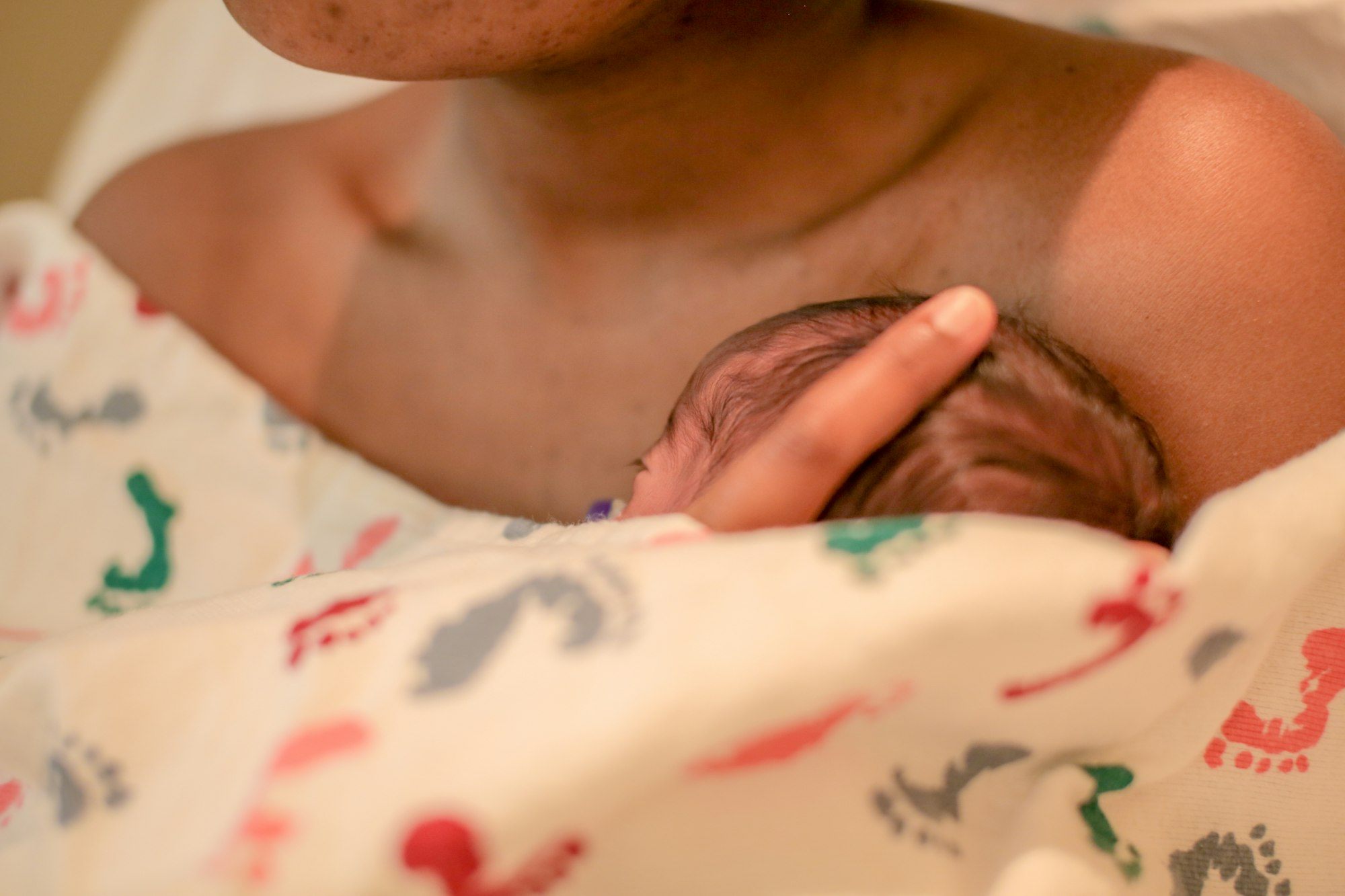The moment your baby is born, something powerful happens. Amid the chaos of the delivery room, there’s a simple, almost magical act that can shape your baby’s health and your bond for years to come: skin-to-skin contact.
You’ve probably heard the term before, maybe even seen photos of tiny newborns tucked against their parent’s chest. But why does it matter so much?
What Is Skin-to-Skin Contact?
Skin-to-skin contact (often shortened to SSC or called “kangaroo care”) means placing your naked baby—diaper only—directly on your bare chest after birth. Ideally, this happens within the first few minutes of life, often before your baby is even weighed or cleaned. A warm blanket is placed over both of you, and the magic begins.
This isn’t just a feel-good moment. It kickstarts a chain reaction in your baby’s body—and yours.
The Benefits for Your Baby
- Breathing becomes more effortless and rhythmic
- Heart rate is more stable
- Oxygen levels improve
- Blood sugar levels stay balanced
- Body temperature is regulated naturally (2)
- Blood pressure remains normal
- Pain is reduced thanks to a natural analgesic effect
- Baby is colonized by mom’s healthy bacteria (4)—not hospital germs
- Breastfeeding starts sooner and lasts longer
- Promotes strong emotional bonding
- Calmer, less fussy behavior
- Overall soothing experience for both parent and child
- Long-term developmental advantages (5)
These benefits apply to all full-term babies. But when a baby is premature or has low birth weight, skin-to-skin care (also called Kangaroo Mother Care) becomes even more crucial—potentially life-saving. (1)

The Benefits of Skin-to-skin Contact for Mothers
Skin-to-skin contact isn’t just good for babies—it’s powerful for mothers too. Here’s how it helps:
- Boosts Oxytocin: This hormone, often called the “love hormone,” surges during skin-to-skin (3), promoting bonding and emotional connection.
- Supports Breastfeeding: SSC encourages early and more effective latching, increases milk production, and helps establish a strong breastfeeding relationship.
- Reduces Stress and Anxiety: Physical closeness with your baby has a calming effect, lowering cortisol levels and increasing confidence in caring for your newborn.
- Improves Post-Birth Recovery: It can shorten the third stage of labor, reduce postpartum bleeding, and ease the transition into motherhood.
- Encourages Maternal Instincts: The act of holding your baby skin-to-skin helps mothers tune into their baby’s cues, enhancing responsiveness and care.
- Fights the Baby Blues: Mothers who practice early skin-to-skin contact often report fewer symptoms of postpartum depression or anxiety.
Whether you’ve had a vaginal birth or a C-section, these benefits apply. And if you’re feeling overwhelmed, know that this connection can be grounding and empowering.
What About Skin-to-Skin Contact with Dad?
Yes! Dads (and partners) can absolutely do skin-to-skin care too.
If the mother isn’t able—due to a C-section, complications, or simply needing a breather—dad can step in. He can also help out with multiples, taking turns so each baby gets the care they need.
While dad may not breastfeed, his body still provides all the other vital benefits: warmth, stability, connection. Feeding can happen with expressed breast milk or formula using a cup, syringe, or bottle.
This is about partnership—and building that father-baby bond from hour one.

The Breast Crawl
When babies are allowed skin-to-skin contact right after birth, they often go through a predictable set of stages:
1. Birth Cry
That magical sound—we all wait for it. Baby’s lungs expand, and we hear that first breath of life.
2. Relaxation
Baby stops crying and snuggles into your chest. Still. Quiet. Blissful.
3. Awakening
Eyes begin to open. Tiny movements start—shoulders, head, mouth. This happens about 3 minutes after birth.
4. Activity
Rooting and suckling behaviors kick in. Baby starts moving toward the breast—usually around 8 minutes in.
5. Rest
Little pauses to recharge—totally normal and healthy.
6. Crawling
This isn’t a crawl like we think of it—but determined, squirmy movement toward the breast. Usually begins around 35 minutes in.
7. Familiarization
Baby licks, touches, and smells the breast. This lasts about 20 minutes. Around 45 minutes post-birth.
8. Suckling
Baby latches on and begins feeding, usually around the one-hour mark. Colostrum (the first milk) is rich, golden, and exactly what your baby needs.
9. Sleep
A full, happy baby—and likely a full, happy mom—both rest, around 1.5 to 2 hours after birth.
Throughout this entire process, a nurse or doctor should be close by—especially if you had medication or surgery during delivery—to ensure safety.
Make It Part of Your Birth Plan
If skin-to-skin feels right to you, write it into your birth plan. Talk to your doctor, midwife, or care team ahead of time.
Sadly, not every provider is familiar with all the benefits. You may need to advocate for it. Be specific:
- Request at least an hour of uninterrupted skin-to-skin contact after birth
- Ask that all newborn medications (eye ointment, Vitamin K) be given while baby is on your chest
- Delay weighing, measuring, or bathing until after
If you have a vaginal delivery, your baby can be placed on your abdomen or chest right away—even while you deliver the placenta or get stitches.
If you’re having a C-section, ask your doctor about options for immediate skin-to-skin contact in the operating room or as soon as you’re stable in recovery.
The message is this: you have a say. It’s your birth. Your baby. Your bonding time.
Final Thoughts: Simple, Powerful, Yours
Skin-to-skin contact is one of the most powerful ways to welcome your baby into the world. It’s instinctive. It’s science-backed. And it’s something that you, your partner, and your baby will benefit from—physically, emotionally, hormonally.
So as you plan for birth, don’t forget this beautifully basic step. The warmth of your skin might just be the best gift you give your baby from the very beginning.
No wires. No machines. Just love, connection, and a whole lot of oxytocin.
References
- The World Health Organization says starting skin-to-skin right after birth—especially for preemies and tiny newborns—can be a real lifesaver. It’s not just nice; it’s essential. (link 1)
- The NHS backs it too: placing your baby on your bare chest helps steady their breathing, heart rate, and body temperature. Your body becomes their personal thermostat. (link 2)
- According to research from PMC, this close contact gives mom a boost of oxytocin—the bonding hormone—which helps with connection and even getting the placenta out. Meanwhile, baby gets a hormonal kickstart too, helping them adjust to the outside world. (link 3)
- That same PMC study also shows skin-to-skin helps babies pick up their mom’s healthy bacteria right away—a big win, especially for babies born by C-section who might otherwise miss out. (link 4)
- And long-term? A study from Frontiers in Psychology found that babies who had early skin-to-skin time often had stronger, more connected relationships with their moms years down the line. (link 5)


